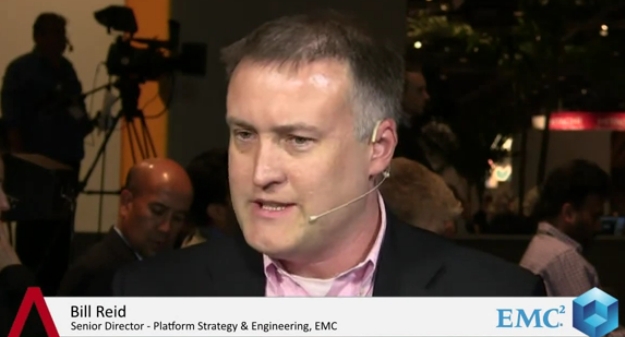 NEWS
NEWS
 NEWS
NEWS
 NEWS
NEWS
![]() Bill Reid, Senior Director – Platform Strategy & Engineering with EMC, spoke with John Furrier and David Floyer on theCUBE at SapphireNOW 2013, about virtualization, business motivation, business value, and EMC’s journey.
Bill Reid, Senior Director – Platform Strategy & Engineering with EMC, spoke with John Furrier and David Floyer on theCUBE at SapphireNOW 2013, about virtualization, business motivation, business value, and EMC’s journey.
Asked about the method used by EMC to consolidate and virtualize SAP within the organization, Bill Reid spoke about the “journey” that took 27 months and consisted in the virtualization and consolidation of legacy systems and legacy toolsets, whose scope was enabling EMC’s business for the next decade.
As they were browsing the opportunities for consolidation, they took a greenfield approach, and SAP became the obvious choice.
From a technology point of view, the end goal was a system that was flexible, scalable, easy to manage and easy to maintain in the future.
Speaking about the business motivation, Reid admitted that, unlike previous changes in the company which were focused on technology, this one was driven by the business. After carefully analyzing the market, the realization hit that EMC’s position a decade ago was not the goal for the decade to come. Hence, the focus on the business capabilities that SAP promised to deliver.
Reid is adamant about the benefits of single global instance. That means consolidation of strategy, consolidation of processes – be it financial or integration controls – easier management across the business units. It also means more complexity.
“Businesses have to understand that, by region, you cannot operate as an independent entity. You’ve got to know why and how it affects the global costs of ownership”, said Reid.
The technological journey regarding virtualization within EMC didn’t start with SAP; it started around 2003, 2004. And around a year before deciding to move towards SAP, EMC started using VMware and VBlock. The effects were almost immediate, and so, the decision towards the virtualization was almost a no-brainer.
As for the savings, the benefits of virtualization can be estimated between 35 to 40 percent of hardware costs, compared to nine years ago. Hardware, licensing, resource management — it all adds up. Convergent infrastructure helps return initial capital investment.
From a pure environmental standpoint, EMC started with about 160 applications in the legacy ERP toolsets; by consolidating them into the SAP stack, there are now only around 60 applications left over.
The success is also measurable in business SLA – how fast an order can be processed and shipped to a customer.
There are two aspects when it comes to integration:
“With the cloud being around for a while now, the SLA getting better and the hosting capabilities within the cloud emerging, there’s more and more oportunity to start decoupling capabilities from what used to be tradionally in-your-data-center-only opportunities to a platform outside your four walls”, explained Reid.
EMC’s concept is called application-integration cloud. Reid warned that the “integration will be the linchpin that, if it goes apart, so goes your business.”
Refering to the market trend, John Furrier brought into discussion Bill McDermott’s speech at the press conference. He said that traditional infrastructure resembled the process of hiring a contractor to build one’s house. It would mean a lot of subcontractors and a lot of hassle. New trends, on the other hand, are more similar to prefabricated housing. That may not be as glamorous as a craftsman’s house, but it sure is easier to put together. Speed is the key in the business sector. Speed is important because the tech evolves and changes at a very fast rate.
In that respect, EMC’s current platform is more like a foundation of releases, allowing for agile releases and for additional capabilities on top of that.
HANA went live two months later after the SAP implementation, in September 2012, being vital for the company, which needed real time reporting, and the right information in order to make the right decisions.
Within EMC though, despite SAP having indeed a large footprint, it does not represent the entire data center. There are other SaaS solutions, other HR toolsets, other CRM tools. Aggregation is done with a GreenPlum appliance.
Self-service consumption is the ultimate goal, where the users can come in and self-service their needs, instead of requesting that to IT and receiving something that may or may not reflect their needs.
Explaining the business value of this consolidation and virtualization, Reid mentioned the company’s backlog report that took an average of 20-40 minutes to process. The same report takes now under two minutes with HANA target. Furrier relayed a similar story from another customer, whose report took around 25 days to generate, and which is now ready in 25 seconds.
So, the bottom line with this new environment is the clear reduction in complexity, eliminating unnecessary interaction between the applications, and speeding things up. It’s a much simpler environment to work with.
Wrapping up the interview, Bill Reid offered a simple advice for his peers: “Don’t shy away from new capabilities; the benefits are obvious. And always think about the future.”
Support our mission to keep content open and free by engaging with theCUBE community. Join theCUBE’s Alumni Trust Network, where technology leaders connect, share intelligence and create opportunities.
Founded by tech visionaries John Furrier and Dave Vellante, SiliconANGLE Media has built a dynamic ecosystem of industry-leading digital media brands that reach 15+ million elite tech professionals. Our new proprietary theCUBE AI Video Cloud is breaking ground in audience interaction, leveraging theCUBEai.com neural network to help technology companies make data-driven decisions and stay at the forefront of industry conversations.